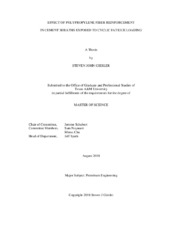| dc.description.abstract | Cement slurry is pumped downhole to create cement sheaths that induce zonal isolation and maintain well integrity throughout the well’s lifetime. This task is difficult to achieve due to adverse wellbore conditions and rig operations. In particular, hydraulic fracturing stimulation generates temperature- and pressure-induced stresses detrimental to the cement sheath. Recent studies have found that deviated wells, commonly drilled to access unconventional reservoirs, are three times more likely than non-deviated wells to lose zonal isolation. Due to recent increases in unconventional oil and natural gas production, this problem is relevant to the industry today.
An experiment was built to mimic wellbore conditions during hydraulic fracturing. Cement sheath samples were cured at wellbore conditions of 6,000 psi and 250°F, then tested at these conditions to evaluate performance under cyclic loading. Internal casing pressure was applied to a restraining cement sheath, then cycled from the wellbore confining pressure to a positive pressure differential and back to the confining pressure. Samples endured the applied stress initially, but failed after reaching their respective fatigue limits due to cyclic fatigue. Unfortunately, equipment failure prevented the completion of tests at wellbore conditions, so a modified experiment was conducted without wellbore curing or confining pressure.
The primary research objective was to conduct cyclic fatigue tests on cement sheaths reinforced with polypropylene fibers, then compare results with cement sheaths that were not reinforced. There were two baseline slurries without fibers: one contained Class H cement plus 35% by weight of cement (bwoc) silica flour while the other contained Class H cement plus 35% bwoc silica flour plus 8% bwoc bentonite. Polypropylene fibers were added at a concentration of 0.75% by volume of batch (bvob). Fiber reinforcement doubled the fatigue life of cement sheaths without bentonite and had a negligible impact on the cement sheaths containing bentonite.
The secondary research objective was to observe crack initiation and propagation in computed tomography (CT) scans of the cement sheath before, during, and after cyclic fatigue testing. Cross-sectional scans displayed mature radial and disk cracks, however crack initiation and propagation was not clearly observed. | en |


